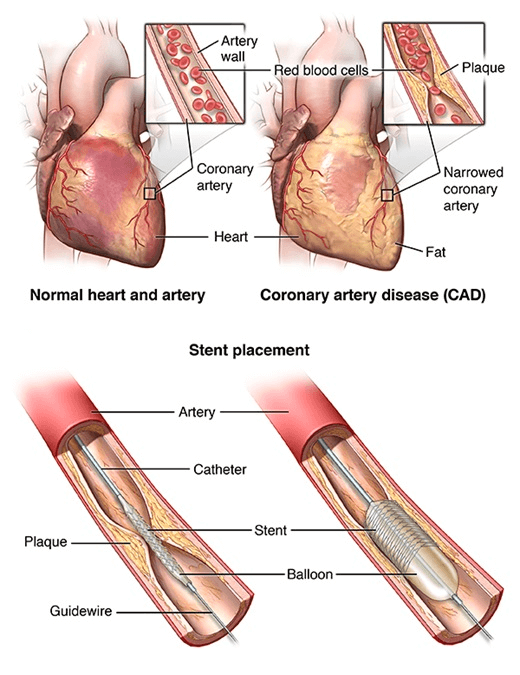Coronary Angioplasty at Cordis Cathlab
Coronary angioplasty is a medical treatment used to open the blocked and narrowed arteries and regulate proper blood flow to your heart. Your heart requires unobstructed blood flow. However, as you get older, your risk of developing coronary artery disease increases. As a result, these arteries get narrowed or completely blocked. The arteries can also get blocked due to the accumulation of plaque. Initially, the doctor might prescribe medications to help relieve your chest pain due to the narrowed arteries. If it doesn’t work, the last resort is coronary angioplasty.

2000+ Angioplasties
Coronary Angioplasty procedure
The procedure is performed using a stent or balloon. In coronary angioplasty stent, the doctor places a wire tube to stretch open the clogged arteries. These stents are filled with the liquid that keeps the coronary arteries open and ensures proper blood supply to your heart.
Alternatively in Balloon coronary angioplasty, a balloon is inserted into the clogged artery and is inflated to open it. The doctor makes a small cut in your wrist or groin to insert a catheter, a thin tube into the arteries. They use x-rays to get this tube to the target artery. They inject a special dye into the blocked artery to get a clear picture of the blockage. They insert the balloon and inflate it inside the blocked artery so that the plaque is pushed against the wall and the blockage is cleared. The balloon can be used in conjunction with the stent to keep the blocked artery open after the balloon is deflated, or it can be used alone.
Here’s how coronary angioplasty is performed.
You are given local anesthesia so that you don’t feel any discomfort when the incision is made in your wrist, arm, or groin and the stent is placed. As mentioned earlier, the balloon is inflated inside the artery to push the fatty deposits against the wall and create sufficient space for the blood to flow freely to/from your heart. The balloon is then deflated, and the stent is placed in the affected artery to keep it open.
The procedure might take anywhere between 1 and 2 hours (depending on the method used to treat your blocked arteries). Most people are given discharge the same day or 1-2 days after the procedure. The doctor will give you instructions regarding what to avoid. Usually, you are advised to avoid any strenuous exercises and physical practices that might put excess strain on your chest for a few weeks. You must also avoid driving for a few days following the treatment.
Usually, coronary angioplasty is performed to treat chest pain from angina. However, it is also used as an emergency procedure for people who’ve suffered a heart attack. If you are diagnosed with a heart attack, you may have to stay in hospital for a couple of weeks after getting coronary angioplasty. The doctor will recommend a few medicines to prevent the risk of blood clots. You can resume your routine activities within a week after angioplasty. How long you have to stay in the hospital depends on your recovery period.
Is coronary angioplasty surgery Safe?
Coronary angioplasty doesn’t involve any major incision, so it’s mostly safe for older people. In fact, people above 65 years are usually recommended coronary angioplasty to reduce their risk of developing coronary heart diseases. It is a minimally invasive form of treatment. Although the procedure doesn’t involve any serious risks of complications, some patients might suffer from heavy bleeding around the incision, a stroke, or a heart attack after angioplasty. There is a risk of blood clot formation in your stent after angioplasty. You need to take aspirin and other blood-thinner medication to reduce the risk of blood clots. There is also a risk of the artery getting clogged again.
Angioplasty might not work if you have several blocked arteries or the blockage is too severe to be treated without bypass surgery — an invasive procedure in which the doctor removes the blood vessels of healthy parts of your body and replaces the blocked arteries with them. Your age, the reason you are getting coronary angioplasty, and your health are a few factors that determine your risk of complications from this treatment.
How to Prepare for Coronary Angioplasty?
Coronary angioplasty is recommended for people suffering from angina, heart stroke, heart attack, and other coronary artery diseases. The doctor will perform a physical test, such as X-ray and blood tests, to determine whether you are an ideal candidate for the procedure. Before angioplasty, the doctor will perform an angiogram to get a clear picture of the blockage in the blood vessels leading to your heart. It will help them decide if the blockage can be treated with angioplasty or will you need bypass surgery.
You must stop taking all types of blood-thinning medications, including aspirin, before angioplasty. Inform your doctor about any herbal supplements or other medications you are currently taking. Your doctor will ask you to avoid fluids and food a few hours before undergoing an angiogram. If you are currently taking any medication, make sure you take it with only a few sips of water. Do not take any medicine before getting your doctor’s approval. Ideally, the doctor asks you to stop taking medicines a few days before angioplasty. It’s also advisable to arrange for your transportation a day or two after angioplasty, as you won’t be able to drive immediately after the procedure.
Request Appointment
Request an appointment with us to know more about coronary angiography procedure and if you do require an angioplasty
